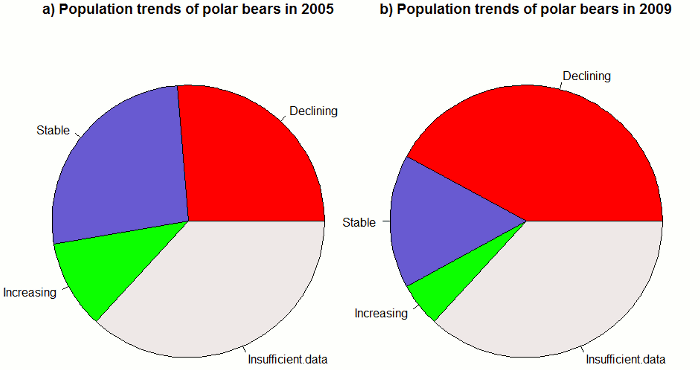
Polar bears are found in the Arctic circle and surrounding land masses. There are 19 recognised subpopulations, and estimates place their numbers at about 20,000 to 25,000. Polar bears are classed as vulnerable by the World Conservation Union (IUCN) and listed as a threatened species under the US Endangered Species Act. Yet some claim that polar bear numbers have increased since the 1950s and are now stable. So what is the situation for this species?
First of all, a few points need to be made about polar bear numbers:
With this caveat in mind, what do the figures actually say? According to a 2009 report by the IUCN Polar Bear Specialist Group, of the 19 recognised subpopulations of polar bears, 8 are in decline, 1 is increasing, 3 are stable and 7 don’t have enough data to draw any conclusions. Figure 1 below compares the data for 2005 and 2009.

Figure 1: Subpopulation status of polar bears for 2005 and 2009 (Source: Polar Bear Specialist Group)
Both habitat degradation and over-harvesting are responsible for the decline in some subpopulations. To understand why the IUCN and US Endangered Species Act consider polar bears to be at risk, it is important to look at how rising temperatures are likely to affect their habitat in the future. Polar bears are highly specialised mammals which rely heavily on sea ice for food and other aspects of their life cycle. Satellite data show that Arctic sea ice has been decreasing for the past 30 years, and projections show that this trend will continue as temperatures carry on rising. The changes in sea ice affect polar bears in several ways:
To get an idea of the potential impacts of future climate change on polar bears, we can look at subpopulations found at the bears’ southern range, where habitat changes have been most noticeable so far. A good example is the western Hudson Bay subpopulation, which is one of the best studied. Here, ice floe break-up is taking place earlier than 30 years ago, effectively reducing the feeding period by about three weeks. As a result, the average weight of female polar bears has dropped by about 21% between 1980 and 2004, and the population declined by 22% between 1987 and 2004. In Alaska, there is evidence of increased cub mortality caused by a decline in sea ice.
In conclusion, the reason polar bears have been classed as threatened comes from the impacts of future climate change on the bears’ habitat. Current analysis of subpopulations where data is sufficient clearly shows that those subpopulations are mainly in decline. Further habitat degradation will increase the threats to polar bears.
This post is the Basic Version (written by Anne-Marie Blackburn) of the skeptic argument "Polar bear numbers are increasing".
Posted by Anne-Marie Blackburn on Thursday, 30 September, 2010
 |
The Skeptical Science website by Skeptical Science is licensed under a Creative Commons Attribution 3.0 Unported License. |